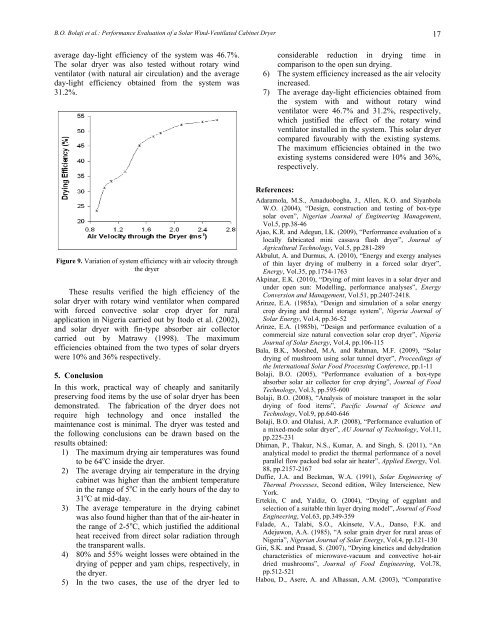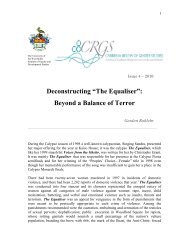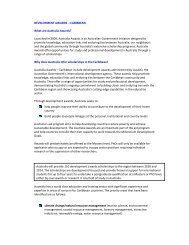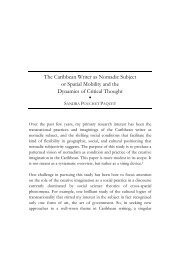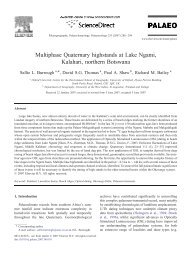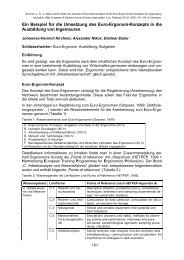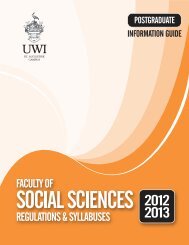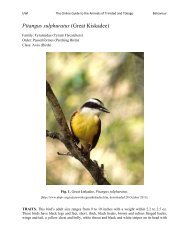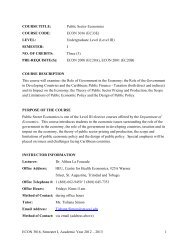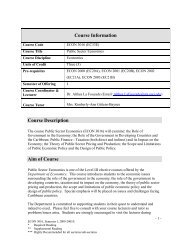Performance Evaluation of a Solar Wind-Ventilated Cabinet Dryer
Performance Evaluation of a Solar Wind-Ventilated Cabinet Dryer
Performance Evaluation of a Solar Wind-Ventilated Cabinet Dryer
Create successful ePaper yourself
Turn your PDF publications into a flip-book with our unique Google optimized e-Paper software.
B.O. Bolaji et al.: <strong>Performance</strong> <strong>Evaluation</strong> <strong>of</strong> a <strong>Solar</strong> <strong>Wind</strong>-<strong>Ventilated</strong> <strong>Cabinet</strong> <strong>Dryer</strong> 17<br />
average day-light efficiency <strong>of</strong> the system was 46.7%.<br />
The solar dryer was also tested without rotary wind<br />
ventilator (with natural air circulation) and the average<br />
day-light efficiency obtained from the system was<br />
31.2%.<br />
Figure 9. Variation <strong>of</strong> system efficiency with air velocity through<br />
the dryer<br />
These results verified the high efficiency <strong>of</strong> the<br />
solar dryer with rotary wind ventilator when compared<br />
with forced convective solar crop dryer for rural<br />
application in Nigeria carried out by Itodo et al. (2002),<br />
and solar dryer with fin-type absorber air collector<br />
carried out by Matrawy (1998). The maximum<br />
efficiencies obtained from the two types <strong>of</strong> solar dryers<br />
were 10% and 36% respectively.<br />
5. Conclusion<br />
In this work, practical way <strong>of</strong> cheaply and sanitarily<br />
preserving food items by the use <strong>of</strong> solar dryer has been<br />
demonstrated. The fabrication <strong>of</strong> the dryer does not<br />
require high technology and once installed the<br />
maintenance cost is minimal. The dryer was tested and<br />
the following conclusions can be drawn based on the<br />
results obtained:<br />
1) The maximum drying air temperatures was found<br />
to be 64 o C inside the dryer.<br />
2) The average drying air temperature in the drying<br />
cabinet was higher than the ambient temperature<br />
in the range <strong>of</strong> 5 o C in the early hours <strong>of</strong> the day to<br />
31 o C at mid-day.<br />
3) The average temperature in the drying cabinet<br />
was also found higher than that <strong>of</strong> the air-heater in<br />
the range <strong>of</strong> 2-5 o C, which justified the additional<br />
heat received from direct solar radiation through<br />
the transparent walls.<br />
4) 80% and 55% weight losses were obtained in the<br />
drying <strong>of</strong> pepper and yam chips, respectively, in<br />
the dryer.<br />
5) In the two cases, the use <strong>of</strong> the dryer led to<br />
considerable reduction in drying time in<br />
comparison to the open sun drying.<br />
6) The system efficiency increased as the air velocity<br />
increased.<br />
7) The average day-light efficiencies obtained from<br />
the system with and without rotary wind<br />
ventilator were 46.7% and 31.2%, respectively,<br />
which justified the effect <strong>of</strong> the rotary wind<br />
ventilator installed in the system. This solar dryer<br />
compared favourably with the existing systems.<br />
The maximum efficiencies obtained in the two<br />
existing systems considered were 10% and 36%,<br />
respectively.<br />
References:<br />
Adaramola, M.S., Amaduobogha, J., Allen, K.O. and Siyanbola<br />
W.O. (2004), “Design, construction and testing <strong>of</strong> box-type<br />
solar oven”, Nigerian Journal <strong>of</strong> Engineering Management,<br />
Vol.5, pp.38-46<br />
Ajao, K.R. and Adegun, I.K. (2009), “<strong>Performance</strong> evaluation <strong>of</strong> a<br />
locally fabricated mini cassava flash dryer”, Journal <strong>of</strong><br />
Agricultural Technology, Vol.5, pp.281-289<br />
Akbulut, A. and Durmus, A. (2010), “Energy and exergy analyses<br />
<strong>of</strong> thin layer drying <strong>of</strong> mulberry in a forced solar dryer”,<br />
Energy, Vol.35, pp.1754-1763<br />
Akpinar, E.K. (2010), “Drying <strong>of</strong> mint leaves in a solar dryer and<br />
under open sun: Modelling, performance analyses”, Energy<br />
Conversion and Management, Vol.51, pp.2407-2418.<br />
Arinze, E.A. (1985a), “Design and simulation <strong>of</strong> a solar energy<br />
crop drying and thermal storage system”, Nigeria Journal <strong>of</strong><br />
<strong>Solar</strong> Energy, Vol.4, pp.36-52<br />
Arinze, E.A. (1985b), “Design and performance evaluation <strong>of</strong> a<br />
commercial size natural convection solar crop dryer”, Nigeria<br />
Journal <strong>of</strong> <strong>Solar</strong> Energy, Vol.4, pp.106-115<br />
Bala, B.K., Morshed, M.A. and Rahman, M.F. (2009), “<strong>Solar</strong><br />
drying <strong>of</strong> mushroom using solar tunnel dryer”, Proceedings <strong>of</strong><br />
the International <strong>Solar</strong> Food Processing Conference, pp.1-11<br />
Bolaji, B.O. (2005), “<strong>Performance</strong> evaluation <strong>of</strong> a box-type<br />
absorber solar air collector for crop drying”, Journal <strong>of</strong> Food<br />
Technology, Vol.3, pp.595-600<br />
Bolaji, B.O. (2008), “Analysis <strong>of</strong> moisture transport in the solar<br />
drying <strong>of</strong> food items”, Pacific Journal <strong>of</strong> Science and<br />
Technology, Vol.9, pp.640-646<br />
Bolaji, B.O. and Olalusi, A.P. (2008), “<strong>Performance</strong> evaluation <strong>of</strong><br />
a mixed-mode solar dryer”, AU Journal <strong>of</strong> Technology, Vol.11,<br />
pp.225-231<br />
Dhiman, P., Thakur, N.S., Kumar, A. and Singh, S. (2011), “An<br />
analytical model to predict the thermal performance <strong>of</strong> a novel<br />
parallel flow packed bed solar air heater”, Applied Energy, Vol.<br />
88, pp.2157-2167<br />
Duffie, J.A. and Beckman, W.A. (1991), <strong>Solar</strong> Engineering <strong>of</strong><br />
Thermal Processes, Second edition, Wiley Interscience, New<br />
York.<br />
Ertekin, C and, Yaldiz, O. (2004), “Drying <strong>of</strong> eggplant and<br />
selection <strong>of</strong> a suitable thin layer drying model”, Journal <strong>of</strong> Food<br />
Engineering, Vol.63, pp.349-359<br />
Falade, A., Talabi, S.O., Akinsete, V.A., Danso, F.K. and<br />
Adejuwon, A.A. (1985), “A solar grain dryer for rural areas <strong>of</strong><br />
Nigeria”, Nigerian Journal <strong>of</strong> <strong>Solar</strong> Energy, Vol.4, pp.121-130<br />
Giri, S.K. and Prasad, S. (2007), “Drying kinetics and dehydration<br />
characteristics <strong>of</strong> microwave-vacuum and convective hot-air<br />
dried mushrooms”, Journal <strong>of</strong> Food Engineering, Vol.78,<br />
pp.512-521<br />
Habou, D., Asere, A. and Alhassan, A.M. (2003), “Comparative


